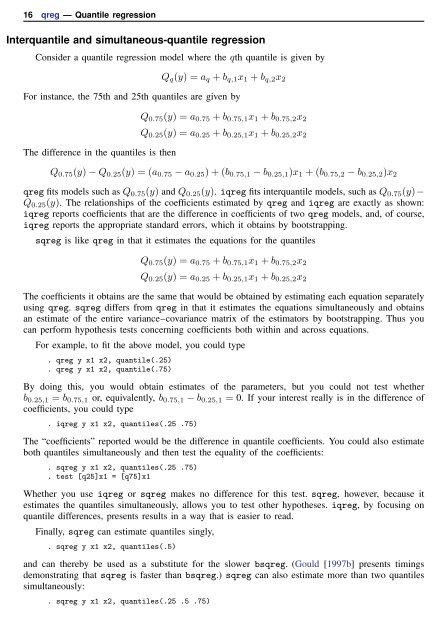qreg - Stata
qreg - Stata
qreg - Stata
Create successful ePaper yourself
Turn your PDF publications into a flip-book with our unique Google optimized e-Paper software.
16 <strong>qreg</strong> — Quantile regression<br />
Interquantile and simultaneous-quantile regression<br />
Consider a quantile regression model where the qth quantile is given by<br />
Q q (y) = a q + b q,1 x 1 + b q,2 x 2<br />
For instance, the 75th and 25th quantiles are given by<br />
The difference in the quantiles is then<br />
Q 0.75 (y) = a 0.75 + b 0.75,1 x 1 + b 0.75,2 x 2<br />
Q 0.25 (y) = a 0.25 + b 0.25,1 x 1 + b 0.25,2 x 2<br />
Q 0.75 (y) − Q 0.25 (y) = (a 0.75 − a 0.25 ) + (b 0.75,1 − b 0.25,1 )x 1 + (b 0.75,2 − b 0.25,2 )x 2<br />
<strong>qreg</strong> fits models such as Q 0.75 (y) and Q 0.25 (y). i<strong>qreg</strong> fits interquantile models, such as Q 0.75 (y)−<br />
Q 0.25 (y). The relationships of the coefficients estimated by <strong>qreg</strong> and i<strong>qreg</strong> are exactly as shown:<br />
i<strong>qreg</strong> reports coefficients that are the difference in coefficients of two <strong>qreg</strong> models, and, of course,<br />
i<strong>qreg</strong> reports the appropriate standard errors, which it obtains by bootstrapping.<br />
s<strong>qreg</strong> is like <strong>qreg</strong> in that it estimates the equations for the quantiles<br />
Q 0.75 (y) = a 0.75 + b 0.75,1 x 1 + b 0.75,2 x 2<br />
Q 0.25 (y) = a 0.25 + b 0.25,1 x 1 + b 0.25,2 x 2<br />
The coefficients it obtains are the same that would be obtained by estimating each equation separately<br />
using <strong>qreg</strong>. s<strong>qreg</strong> differs from <strong>qreg</strong> in that it estimates the equations simultaneously and obtains<br />
an estimate of the entire variance–covariance matrix of the estimators by bootstrapping. Thus you<br />
can perform hypothesis tests concerning coefficients both within and across equations.<br />
For example, to fit the above model, you could type<br />
. <strong>qreg</strong> y x1 x2, quantile(.25)<br />
. <strong>qreg</strong> y x1 x2, quantile(.75)<br />
By doing this, you would obtain estimates of the parameters, but you could not test whether<br />
b 0.25,1 = b 0.75,1 or, equivalently, b 0.75,1 − b 0.25,1 = 0. If your interest really is in the difference of<br />
coefficients, you could type<br />
. i<strong>qreg</strong> y x1 x2, quantiles(.25 .75)<br />
The “coefficients” reported would be the difference in quantile coefficients. You could also estimate<br />
both quantiles simultaneously and then test the equality of the coefficients:<br />
. s<strong>qreg</strong> y x1 x2, quantiles(.25 .75)<br />
. test [q25]x1 = [q75]x1<br />
Whether you use i<strong>qreg</strong> or s<strong>qreg</strong> makes no difference for this test. s<strong>qreg</strong>, however, because it<br />
estimates the quantiles simultaneously, allows you to test other hypotheses. i<strong>qreg</strong>, by focusing on<br />
quantile differences, presents results in a way that is easier to read.<br />
Finally, s<strong>qreg</strong> can estimate quantiles singly,<br />
. s<strong>qreg</strong> y x1 x2, quantiles(.5)<br />
and can thereby be used as a substitute for the slower bs<strong>qreg</strong>. (Gould [1997b] presents timings<br />
demonstrating that s<strong>qreg</strong> is faster than bs<strong>qreg</strong>.) s<strong>qreg</strong> can also estimate more than two quantiles<br />
simultaneously:<br />
. s<strong>qreg</strong> y x1 x2, quantiles(.25 .5 .75)
















